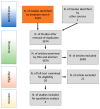Effects of Composite Attachments on Orthodontic Clear Aligners Therapy: A Systematic Review
- PMID: 35057250
- PMCID: PMC8778413
- DOI: 10.3390/ma15020533
Effects of Composite Attachments on Orthodontic Clear Aligners Therapy: A Systematic Review
Abstract
This systematic review aims to highlight the differences between different clear aligner therapies that differ in the presence of attachments or in attachment configuration. Eight electronic databases were searched up to March 2020. Two authors independently proceeded to study selection, data extraction, and risk of bias assessment. The analysis of the results was carried out examining six groups of movements (mesio-distal tipping/bodily movement; anterior bucco-lingual tipping/root torque; posterior bucco-lingual tipping/expansion; intrusion; extrusion; rotation). Five clinical trials were selected and all of them showed a medium risk of bias. Literature showed that attachments mostly increase the effectiveness of orthodontic treatment with clear aligners, improving anterior root torque, rotation, and mesio-distal (M-D) movement; they are also important to increase posterior anchorage. However, some articles showed contradictory or not statistically significant results. Attachments also seem to improve intrusion, but the evidence about this movement, as well as extrusion, is lacking. No studies evaluated posterior bucco-lingual tipping/expansion. Further clinical trials are strongly suggested to clarify the influence of attachments and their number, size, shape, and position on each orthodontic movement.
Keywords: attachments; auxiliary elements; clear aligner therapy; clear aligners; invisalign; invisible orthodontics; systematic review.
Conflict of interest statement
The authors have no conflict of interest to declare.
References
-
- McCance A., Giovannoni R., Maspero C., Periti G., Toma L., Farronato G. Un approccio estetico alla gestione del paziente ortodontico: Il sistema Clearstep. Mondo Ortod. 2010;35:77–86. doi: 10.1016/j.mor.2009.10.006. - DOI
-
- Savignano R., Barone S., Paoli A., Razionale A. FEM analysis of bone-ligaments-tooth models for biomechanical simulation of individual orthodontic devices; Proceedings of the ASME 2014 International Design Engineering Technical Conferences & Computers and Information in Engineering Conference; Buffalo, NY, USA. 17–20 August 2014.
-
- Comba B., Parrini S., Rossini G., Castroflorio T., Deregibus A. A three-dimensional finite element analysis of upper-canine distalization with clear aligners, composite attachments, and class II elastics. J. Clin. Orthod. 2017;51:24–28. - PubMed
-
- Momtaz P. Master’s Thesis. University of Nevada; Las Vegas, NV, USA: 2016. The Effect of Attachment Placement and Location on Rotational Control of Conical Teeth Using Clear Aligner Therapy.
-
- Boyd R. Seminars in Orthodontics. W.B. Saunders; Philadelphia, PA, USA: 2001. Three-dimensional diagnosis and orthodontic treatment of complex malocclusions with the invisalign appliance.


